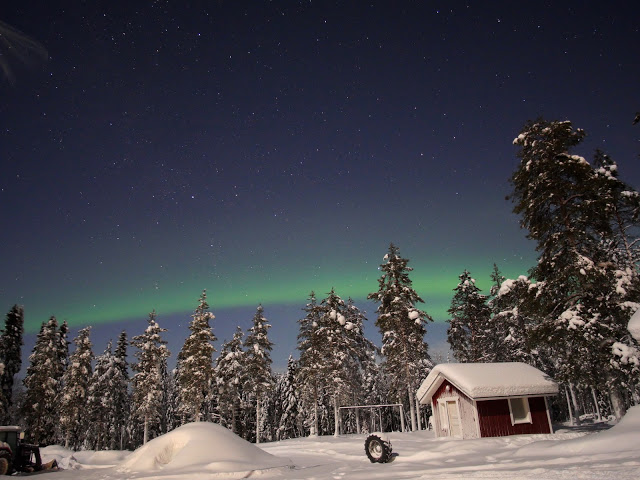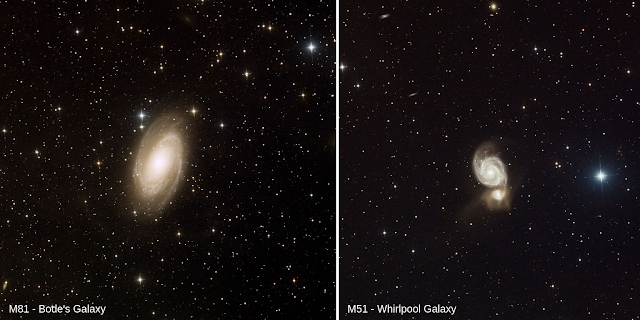As described in a blog post I wrote last year, my wife and I took a trip to Tromso, Norway in late April 2018. While there we caught a planetarium show all about the aurora borealis or 'northern lights', with some wonderful time-lapse photography. We were hooked and decided that at some point in the future we would like to see such displays firsthand for ourselves. Our Tromso trip was too late in the spring to see the auroras, so we'd have to plan another trip in the future, during a more opportune time for viewing.
Fast forward to early this year. My wife every year has a two-week winter holiday from school, and this year it was to take place in mid-February, so this was our chance to try and see the auroras. A promotional deal from Wizz Air to Turku, Finland quickly helped us determine our starting point. After arriving in Turku we traveled by train north to the town of Rovaniemi (home of none other than Santa Claus), right at the Arctic Circle: this was going to be our home base for three days.
Rovaniemi has many tour guides and providers to take visitors on a variety of experiences (husky or reindeer sleigh rides, skiing, ice fishing, snowmobiling, you name it - including viewing auroras of course). Unfortunately, Rovaniemi has its share of light pollution so to really appreciate the auroras it is recommended to find a spot outside of town beyond the reach of the lights. During our first few days in Rovaniemi, we were unsuccessful in seeing any aurora as the weather was either cloudy and/or the light pollution made it impossible to see anything but the moon or the brightest stars.
Our hopes for viewing the aurora rested on a tour we had booked with the tour company "Lapland Welcome" on February 14th. Our aurora tour broke down roughly as follows:
While we were traveling to the observing site our tour guides were keeping an eye open for signs of aurora activity. Auroras can be fleeting and short-lived at times so if it showed itself before we reached our destination the plan was to stop immediately and get our viewing/pictures then. On our trip the aurora borealis finally made an appearance right as we were arriving at our final destination; the guides urged us to quickly go and get some photos while we could as there is no predicting how long it would last. We spent the next 10 minutes climbing a short hill to a better viewing location, and the Aurora picked up right as we arrived at the top.
Needless to say, we were all excited! I kept snapping pictures as long as I could until the aurora faded away, and even then I captured some nice shots of the moon which provided some light to illuminate the landscape.
An aurora (plural: auroras or aurorae), sometimes referred to as polar lights, northern lights (aurora borealis), or southern lights (aurora australis), is a natural light display in the Earth's sky, predominantly seen in the high-latitude regions (around the Arctic and Antarctic).
Auroras are produced when the magnetosphere is sufficiently disturbed by the solar wind that the trajectories of charged particles in both solar wind and magnetospheric plasma, mainly in the form of electrons and protons, precipitate them into the upper atmosphere (thermosphere/exosphere) due to Earth's magnetic field, where their energy is lost.
The resulting ionization and excitation of atmospheric constituents emit light of varying color and complexity. The form of the aurora, occurring within bands around both polar regions, is also dependent on the amount of acceleration imparted to the precipitating particles. Precipitating protons generally produce optical emissions as incident hydrogen atoms after gaining electrons from the atmosphere. Proton auroras are usually observed at lower latitudes. Source: Wikipedia
Read More
Fast forward to early this year. My wife every year has a two-week winter holiday from school, and this year it was to take place in mid-February, so this was our chance to try and see the auroras. A promotional deal from Wizz Air to Turku, Finland quickly helped us determine our starting point. After arriving in Turku we traveled by train north to the town of Rovaniemi (home of none other than Santa Claus), right at the Arctic Circle: this was going to be our home base for three days.
 |
| First sighting of the Aurora Borealis - Photo by Muir Evenden. |
Rovaniemi has many tour guides and providers to take visitors on a variety of experiences (husky or reindeer sleigh rides, skiing, ice fishing, snowmobiling, you name it - including viewing auroras of course). Unfortunately, Rovaniemi has its share of light pollution so to really appreciate the auroras it is recommended to find a spot outside of town beyond the reach of the lights. During our first few days in Rovaniemi, we were unsuccessful in seeing any aurora as the weather was either cloudy and/or the light pollution made it impossible to see anything but the moon or the brightest stars.
Our hopes for viewing the aurora rested on a tour we had booked with the tour company "Lapland Welcome" on February 14th. Our aurora tour broke down roughly as follows:
- 8 PM: Guides pick up clients (us!), go to the office and dress up in warm clothing/boots.
- 8:45 PM: Drive clients to the remote location, about 50 minutes of travel time.
- 10-12 PM: If lucky and the sky is clear and Aurora is present, view/photograph aurora, warm up if needed in the shelter, and snack on provided sausages and hot drinks.
- 12 PM: Return back to Rovaniemi (we got back at our hotel at 1AM).
While we were traveling to the observing site our tour guides were keeping an eye open for signs of aurora activity. Auroras can be fleeting and short-lived at times so if it showed itself before we reached our destination the plan was to stop immediately and get our viewing/pictures then. On our trip the aurora borealis finally made an appearance right as we were arriving at our final destination; the guides urged us to quickly go and get some photos while we could as there is no predicting how long it would last. We spent the next 10 minutes climbing a short hill to a better viewing location, and the Aurora picked up right as we arrived at the top.
 |
| The Aurora Borealis captured at the top of the hill - Photo by Muir Evenden. |
Needless to say, we were all excited! I kept snapping pictures as long as I could until the aurora faded away, and even then I captured some nice shots of the moon which provided some light to illuminate the landscape.
 |
| The Moon illuminating the landscape - Photo by Muir Evenden. |
An aurora (plural: auroras or aurorae), sometimes referred to as polar lights, northern lights (aurora borealis), or southern lights (aurora australis), is a natural light display in the Earth's sky, predominantly seen in the high-latitude regions (around the Arctic and Antarctic).
Auroras are produced when the magnetosphere is sufficiently disturbed by the solar wind that the trajectories of charged particles in both solar wind and magnetospheric plasma, mainly in the form of electrons and protons, precipitate them into the upper atmosphere (thermosphere/exosphere) due to Earth's magnetic field, where their energy is lost.
The resulting ionization and excitation of atmospheric constituents emit light of varying color and complexity. The form of the aurora, occurring within bands around both polar regions, is also dependent on the amount of acceleration imparted to the precipitating particles. Precipitating protons generally produce optical emissions as incident hydrogen atoms after gaining electrons from the atmosphere. Proton auroras are usually observed at lower latitudes. Source: Wikipedia






